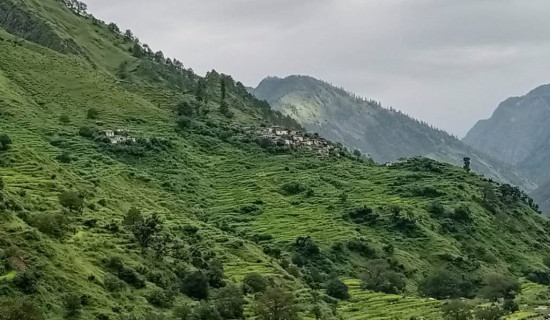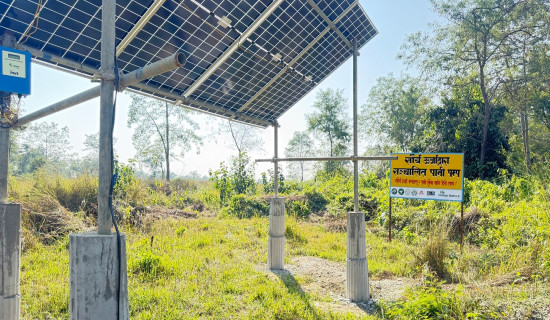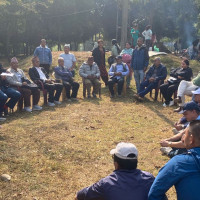- Thursday, 27 November 2025
55 years of change: Canal to road
By Our Correspondent,Biratnagar, Nov. 27: The distance between the Biratnagar branch and its five branches under the Sunsari-Morang Irrigation Project is 27 kilometres. The target was to irrigate 3,700 hectares of cultivable land with the water of the expansion canal in 2020.
It has been 55 years since the canal connected farmers' fields. Biratnagar became a metropolis. In the latest state restructuring, some areas of Budhanagar VDC were incorporated and Biratnagar-18 and Baijnathpur VDC were merged to form Biratnagar-19 ward.
According to the data of the Agriculture and Livestock Development Branch of Biratnagar Metropolitan City, currently 1,375 hectares of land is irrigable within Biratnagar Metropolitan City. According to Prabin Parajuli, agricultural technician of the branch, the Agriculture Development Branch has also been integrated with the Livestock Branch and made one.
The Sunsari-Morang Irrigation Project, built by the Indian government in 1913 and handed over to the Nepal government in 1918, had the capacity to provide irrigation facilities to 68,000 hectares of land in two districts. With increasing urbanization, the irrigated area of land is decreasing. However, the canal built to connect farmers' fields 55 years ago has been converted into a road connecting houses in the city and is now being used for multiple purposes.
Sunsari-Morang Irrigation Project Chief Manohar Kumar Sah says that there is no need to fence off the road if the canal's water flow area is not reduced. However, he says that no one has taken permission so far when other government agencies use the canal in the name of the project. Therefore, the project does not have data on how many kilometres of the canal's water flow area have been converted into blacktop roads.
“The canal is becoming a road corridor by fulfilling its multipurpose goal,” said Project Chief Sah. He explained that even though the purpose of the government-owned land is different, it is being used for the convenience of the citizens. The local, provincial and federal governments have been blacktopping the service road built by the project for cleaning and maintenance of the canal. The process of upgrading and using the canal road as per the demand of the citizens is increasing.
Biratnagar Metropolitan City has so far blacktopped nine kilometres out of the 27 kilometres, informed Arjun Thapa, Chief of the Urban Infrastructure Division. However, apart from that, the Provincial Infrastructure Office has also blacktopped nearly four kilometres of the canal within the metropolis.
Irrigation Project Chief Sah said that even though the federal, local or provincial governments have prepared road structures for the convenience of the citizens, individuals do not have the right to construct structures indiscriminately. He claimed that structures built by individuals encroaching on them can be demolished at any time. However, he explained that the use of the canal has also increased and conservation is also underway after the formation of the local government.
The project has been providing irrigation facilities to 28,000 hectares of land in Morang and 40,000 hectares in Sunsari. This is a 53-kilometre main canal from the Chatara intake, 400 kilometres of branches and canals, and it extends to 1,500 kilometres.
Project Chief Sah says that the villages that emerged at the time of the canal construction have now been transformed into markets, and the markets have now been transformed into cities, so their use has also changed.
Therefore, he says that the locals are now doing everything from building roads, drinking water, and electricity infrastructure on both sides of the canal, from beautification to construction.
The project had been demolishing permanent structures built by individuals encroaching its land until 2018. However, after the local government became active, it is understood that individuals have not built permanent structures on the canal land. Its main canal has the capacity to carry 60 cusecs of water from the Chatara intake.
Project Chief Sah says that water can be sent according to capacity only during the rainy season. In winter, only 10 cusecs of water can be sent to the canal. The reason is that even with water, the river level is depressed.
A survey has not been conducted to determine whether the irrigated area has decreased or not since the canal was built. According to Sah, there is no data on the expansion of cultivable land by clearing forests after the construction of the canal, just as irrigable land has decreased in urban areas.
However, he said that the situation of sending 60 cusecs of water during the rainy season, when necessary, came to a head during the last rainy season.















